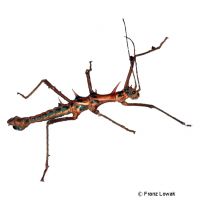Touch Me Not Stick Insect (Epidares nolimetangere)
| Touch Me Not Stick Insect Epidares nolimetangere | |
|---|---|
| Name | Touch Me Not Stick Insect |
| Name Lat. | Epidares nolimetangere |
| Family | Heteropterygids |
| Family lat. | Heteropterygidae |
| Order | Phasmids |
| Order lat. | Phasmatodea |
| Origin | Borneo |
| Habitat | Rainforest |
| Diet | Fresh rose-family leaves |
| Humidity | 70-80 % |
| Behavior | Nocturnal, peaceful |
| Keeping | Individual, pair, group |
| Care Level | Easy |
| Housing | Humid terrarium |
| Breeding | Simple |
| Life Span | 10-20 months |
| Protection | No |
| Metric Units | |
| Size | 3-5 cm |
| Temperature Day | 22-25 °C |
| Temperature Night | 20-22 °C |
| Housing Size | 20 x 20 x 30 cm |
| US Units | |
| Size | 1.2"-2" |
| Temperature Day | 72-77 °F |
| Temperature Night | 68-72 °F |
| Housing Size | 10" x 10" x 10" |
Distribution and habitat
The crepuscular to nocturnal Borneo spiny insects are native to the northwestern part (Sarawak) of the island of Borneo. There, the wingless animals live in the low shrub region and herb layer of the tropical rainforests, where they hide during the day near the ground under bark and foliage.
Maintenance
A terrarium of 20 x 20 x 30 cm (L x W x H) for one animal or a small group is recommended. A terrarium with a cover made of gauze or fine metal mesh is best. The terrarium should be placed in a quiet place without sunlight
They need climbing opportunities, such as cork back walls, twigs and branches, which also serve as food plants. To keep them fresh longer, they should be served in narrow-necked, well-sealed (danger of drowning), stable containers (e.g. vase). The substrate of terrarium humus or a soil-sand mixture at least 5 cm thick, covered with moss, should always be kept slightly moist. Once a day, preferably in the evening, the insectarium should be finely sprayed with water inside (humidity), but a rain or mist system is better. Special attention should be paid to evenly high humidity.
| Daytime temp.: 22-25 °C | Temp. night: 20-22 °C | Humidity: 70-80 |
Although the animals are nocturnal, a light source that also produces the necessary heat is ideal. The lighting duration should be 8-12 hours, depending on the season
Diet
The food supply consists of fresh leaves of blackberry, honeysuckle (Lonicera nitida), laburnum, elderberry and ivy (Hedera helix), as well as leaves of hazel. Leaves of other roses and rose plants, such as red and hawthorn, raspberry, currant, wild rose, etc., as well as the leaves of beech, oak, linden, hazel, eucalyptus, or sweet chestnut are also accepted in different individual ways. Blackberries are ideal as food in winter, as they remain green. Spraying the forage plants allows the animals to satisfy their drinking needs. Additionally, a wick waterer is recommended. Eaten branches, dried and rotten leaves must be removed regularly
A regular and varied diet promotes the well-being of the animals.
Reproduction and breeding
Both sexes are mostly grayish brown to greenish in color. The smaller and clearly slimmer males often have reddish-brown longitudinal stripes and longer spines than the somewhat stronger females.
Over a period of up to 20 months, females lay 1-3 eggs weekly and bury them in the substrate. The eggs are 3-4 mm long and have hairs with small barbs. The incubation period is about 4-6 months, at a temperature of about 25 °C it is much shorter. After the last molt (imaginal molt) the males live for about 9 months, the females can live for about 18-22 months.
Important
The Borneo thorn insects have impressive, powerful thorns on their backs and are therefore also called "touch-me-not stick insects".
Prior to purchase, a terrarium should be prepared that meets the species specific needs. Necessary is good ventilation without drafts and equipment for measuring temperature and humidity. The lighting has to correspond to the species-specific day-night rhythm and has to be placed in such a way that the animals cannot injure themselves
The terrarium should be locked in such a way that neither unauthorized persons can open it nor the animals can escape. Special attention must be paid to thorough hygiene and impurities must be removed regularly
Further literature can be found in your pet store
References
Text: petdata; Image: Franz Lowak
Source: SEILER, BRADLER, KOCH (2000): Ratgeber Phasmiden, Verlag Bede; ENGELMANN & LANGE (2011): Zootierhaltung - Tiere in menschlicher Obhut: Wirbellose, Harri Deutsch Verlag
